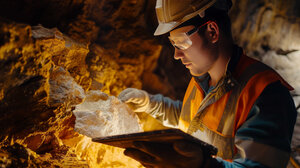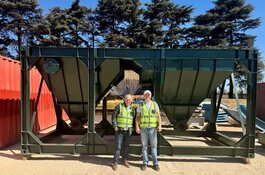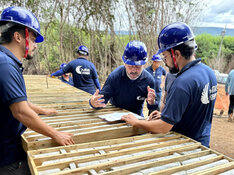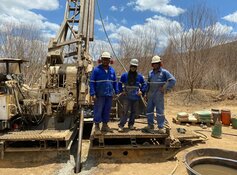Jon Hykawy: It's a case of the general public starting to understand what the electric car might be able to do. As electric cars start to penetrate global markets, that will save the consumer a considerable amount of money, and help develop power infrastructure in the United States, a country now spending $300 billion a year on foreign oil. The electric car will also have a significantly positive effect on the environment—no matter how the electricity is generated. Obviously, lithium batteries will play a critical role because you need a fair bit of lithium per vehicle that is going to be built. I think people are starting to understand that there's going to be a tremendous pull on lithium. That's really what's driving the excitement.
TER: Lithium is not like gold or copper, two of the most commonly mined metals. If someone is investing in lithium companies, what are some lithium basics that investors should know?
JH: Lithium mining is largely dependent on chemistry. The costs really scale with the individual deposit and with the individual chemistry of the brine, if it's a brine deposit.
The first rule of thumb is that lithium is an industrial chemical. There is a defined demand for it. Nobody makes jewelry out of lithium. There's not an insatiable demand for the stuff. You want to find the companies that can produce lithium inexpensively. Frankly, that tends to limit you to looking at brine deposits. You can look at hard rock deposits to the extent that you can look at a company like Talison Lithium Ltd. (TSX:TLH), based in Australia. Talison's ore grade is very, very high. It's really a bit of a mutant in the hard rock space. As a result, there are very few other hard rock projects that we think have any hope of doing anything in the market over the longer term. We tend to tell people to look either at brine deposits or possibly at the clay deposits because some of the clay projects out there, especially Western Lithium USA Corp.'s (TSX.V:WLC;PK:WLCDF) King's Valley lithium project in Nevada, have a shot at coming in at a relatively low cost. And cost is key; on the brine side, you really want what you want in every deposit—high grade. You want a high level of lithium in the brine. In Chile, off of the Atacama Desert, you're going to see grades of 2,000 parts per million (ppm) of lithium. That's at the top of the range. Anything over 800 ppm is a very, very strong deposit. But you also need low levels of contaminants like magnesium and sulfates. If you find all of those things, then you have a reasonable deposit. You just need to couple that with great management and good financing and you have yourself a mine.
TER: Who are the major lithium players at this stage?
JH: At this point, there are four major producers. They've been the four major producers for a significant period of time. Three of them produce from brine deposits in South America. Those are Sociedad Quimica y Minera de Chile SA (NYSE:SQM; SN:SQM), which is the Chilean national mining and chemical company; FMC Lithium (NYSE:FMC), which is part of FMC Corporation; and Chemetall, which is part of Rockwood Holdings, Inc (NYSE:ROC). And, as I mentioned earlier, Talison Lithium. Talison really dominates the market for lithium that's used to manufacture glass and ceramics. But they also sell a fair bit of their lithium to companies in China that produce battery-grade lithium.
TER: And most of it comes from the Greenbushes Lithium Operation in Western Australia, and, as you said, that's a hard rock deposit.
JH: Yes, they produce a mineral called spodumene. The theoretical limit on lithium concentration in spodumene is about 8% lithium. They can produce something that is as close to 8% as it matters.
TER: What's the life expectancy of that operation?
JH: Longer than you or I are going to care. They have a high-grade core of about 4% lithium that probably can last through the next 20 to 40 years. It's a very rich, long-life mine. That's one of the reasons there are no other major hard rock suppliers because the primary market for that material is glass and ceramics. When you have something that's as inexpensive to produce as the spodumene from that high-quality deposit, it's very, very difficult for anybody else to get into that game.
TER: But what about the lithium Talison produces that is used in batteries?
JH: They sell that same spodumene concentrate that contains lithium and other companies in China turn it into battery-grade material, but it's more expensive than producing it from brine.
TER: You talked a little bit about lithium-ion batteries and, in particular, those being used in cars. There was a press release published in early December about Japan's Sanyo doubling its plant production capacity for lithium-ion batteries. Sanyo has contracts to supply Volkswagen and Suzuki. The company says that the market for lithium over the next 10 years will average $6 billion a year. It's worth about $4 billion now. Do we have enough lithium to meet that demand?
JH: Well, first about the figures that you quoted. Lithium batteries are not used in electric vehicles today. The batteries in the Honda Insight or the Toyota Prius, today, are all nickel-metal-hydride batteries. In terms of automotive use, the use of lithium battery is completely greenfield; it's starting essentially from zero. As far as whether we have enough lithium, if you look at a vehicle like the Nissan LEAF, it uses about 4 kilograms (kg.) of lithium metal or about 21 kg. of lithium-carbonate equivalent. We usually quote the amount of lithium shipped in the world as lithium-carbonate equivalent because it's a nice, benign chemical. Last year, the demand for lithium was about 100,000 tons. You can see that one vehicle using 20 kg. of lithium-carbonate equivalent is not going to stretch lithium demand until millions of vehicles are produced each year.
TER: But at the same time, we're seeing a major increase in the price of lithium per ton. It's around $6,500 per ton right now.
JH: I think that's rather high. Lately, the price of industrial-grade lithium has been around $5,000 a ton. And the battery-grade material has been selling for something like $5,600 or $5,700. The historical high prices do run up to $6,500 per ton, though.
TER: But the price for lithium is not set like copper or nickel prices on the London Metals Exchange. Lithium prices are determined by buyers and sellers working out agreements with each other. How is that dynamic influencing junior explorers with lithium projects?
JH: Unfortunately, it's a more complex question than that. But the critical point at this stage is that none of the four key lithium suppliers want to grant offtake agreements to automotive manufacturers. As far as these suppliers are concerned, there's plenty of lithium on the market and the automotive manufacturers should be happy to go out and buy their lithium through negotiated contracts, just like everyone else.
But you can't ask an automotive manufacturer to depend on the fact that they're going to get 50 or 100 tons of lithium on a given day. Maybe there's only $60,000 or $70,000 worth of lithium coming, but if they miss that shipment they could literally cease production to the tune of tens to hundreds of millions of dollars' worth of vehicles. So carmakers will not depend on a spot contract. They need offtake agreements; they need something that's carved in stone.
To that end, what's been happening lately is that a lot of these automotive manufacturers are doing direct offtake agreements with the junior lithium miners. They're actually going out and tying up supply by buying it directly from the juniors.
TER: What are some examples of those?
JH: Well, there's been a few high-profile ones. For example, one of the better-known names in the junior lithium space is Orocobre Limited (TSX:ORL; ASX:ORE). They signed an offtake agreement and development program with Toyota Tsusho. So Orocobre's program seems to be advancing reasonably well. We expect that sometime in the first quarter of 2011 we're going to hear about the finalization of that agreement and an equity injection by Toyota into Orocobre's Salar de Olaroz lithium project in Argentina.
Another company that has signed two separate agreements is Lithium Americas Corp. (TSX:LAC). They have lithium supply agreements with both Magna International Inc. (NYSE:MGA; TSX:MG) and Mitsubishi Corporation (OTCPK:MSBSHY). Lithium Americas' Salar de Cauchari lithium project is just up the road from Orocobre's lithium project in Argentina.
Another Argentine group that signed something recently is Lithium One Inc. (TSX.V:LI). They share the salar that FMC produces lithium from, Salar del Hombre Muerto, in the Argentine desert. That salar produces about 15% of the world's lithium through FMC. Lithium One's agreement is with the Koreans, via Korea Resources (KORES), to supply a number of potential buyers with lithium. There are certainly some frontrunners in this space.
TER: What is it about these deposits in Chile, Argentina and Bolivia that make them so prospective for lithium?
JH: There are a couple of things that are important. One is that the portion of the world that we're talking about—the desert in South America—has been uplifted. Millions of years ago there were small, relatively salty lakes there due to their proximity to the ocean. Those lakes were eventually lifted into the mountains and set on the leeward side so the evaporation rates have been very high. As a result, nature has done a lot of the work.
The salty brine that was left behind is just below the surface where it's protected from further evaporation. It has a high enough concentration of lithium to make it worthwhile to process. But it also has a low enough concentration of contaminants that those materials don't negatively impact the cost of the lithium. That has made the South American desert one of the least expensive places in the world from which to source lithium.
There are other places in the world where this same sort of thing has happened. It's happened in Tibet. It's happened in portions of China. It's happened in a few other places but in most of those places the lithium concentration is low and the concentration of some contaminants, like magnesium, is relatively high. That, unfortunately, has made those deposits uneconomic to mine at this point.
TER: You mentioned Lithium Americas. It owns the Salar de Cauchari lithium-potassium property in Argentina, where pilot-scale processing is underway. You have a speculative buy rating on Lithium Americas with a target price of $2.50. It's trading around $1.90 now. What sort of catalyst is going to bring it up to that level?
JH: What really matters at this point is that Lithium Americas produces a definitive feasibility study that points out the flow sheet that they're going to use to produce lithium. It's a bit of an interesting deposit. They have a reasonably good concentration of lithium but they also have a relatively high abundance of sulfate, one of those contaminant ions. If you had nothing but sulfate, you'd have a bit of a problem and it would be an expense. But they also have a fair bit of potassium in their brine. Potassium and sulfate together are potash. If you could get the chemistry correct and put the right flow sheet together, Lithium Americas could be a relatively inexpensive producer of lithium, as well as a relatively inexpensive producer of fertilizer. The two of them together would make a very interesting revenue stream. You sometimes see those dual revenue streams from some of the major producers, like SQM in Chile.
TER: Has Lithium Americas done studies to determine if they can get the chemistry right?
JH: In theory it's workable. They've worked on it on a pilot-scale basis. What it really comes down to now is finding what the cost is going to be and that's where the feasibility study comes in.
TER: When should that be published?
JH: We're hoping we're going to see something from Lithium Americas relatively early in the New Year. That will give us some comfort.
TER: Well, we'll look forward to that. You also mentioned Lithium One. What's unique about its Sal de Vida Brine Project in Argentina?
JH: Well, one of the geologists who works on the deposit in Argentina had a very good statement about it. We were discussing the deposit's chemistry when he just smiled and said: "God was very good to Lithium One." They have a relatively high abundance of lithium. They have very low magnesium levels. And the sulfate levels are well matched to the two of those. They really have no other contaminants to worry about. It looks a lot like the brine that FMC deals with on the other half of the salar. It's a very good brine. In terms of chemistry, there's very little you could ask for other than even higher levels of lithium. But as far as it goes, Sal de Vida is one of the more straightforward projects that you're going to come across.
TER: You mentioned Western Lithium, too. The company has a clay deposit, the King's Valley lithium project in northern Nevada. Have you been to that project?
JH: I have, yes.
TER: What were some of your thoughts after seeing it firsthand?
JH: Firstly, King's Valley probably contains a never-ending stream of lithium. There are two things that distinguish it. The first is it's in the United States, so the political risk is minimal. The second thing is that there are five lenticular deposits of hectorite clay that effectively contain an inexhaustible supply of lithium. And through the publication of Western Lithium's preliminary feasibility study, the company has shown it can produce battery-grade lithium, or what certainly looks like battery-grade lithium, at a very reasonable cost. The cost outlined in its study would make Western Lithium one of the least expensive producers of battery-grade lithium in the world. That is interesting to us.
The process that Western Lithium is using to recover the lithium looks a lot like the mundane processing of an industrial material like vanadium. While it looks a little like that, it's never been done on a commercial scale. That's still a risk that investors need to keep in mind. This is a novel method for producing lithium. While you can get game-changing results out of novel approaches, you can also get some serious negative surprises once in a while.
TER: What about some other companies with projects that are similar to Western Lithium but perhaps a little further away from production?
JH: There is one. We know this company reasonably well and have visited all their sites. Rodinia Lithium Inc.'s (TSX.V:RM; OTCQX:RDNAF) Salar de Diablillos lithium brine project in Argentina looks like a good one to us. Again, it's one of those deposits that's been blessed by reasonably good chemistry. They've got relatively high levels of lithium. Good magnesium levels. Good sulfate levels. It should be a relatively tractable project. It's not a huge project, but in the larger scheme of things you don't need to be huge. You just need to target the right markets and find some buyers who want to buy the stuff.
TER: With most of these deposits being found in the same part of the world, are we going to see some takeovers?
JH: We've already seen a few. For instance, we've seen Talison take over Salares Lithium and its properties in Chile. The idea of a hard rock player owning brines is an attractive one to me. I like the synergies that come with the two approaches in terms of being able to guarantee delivery to automotive customers, for example. With brine, for example, lithium production is dependent on the weather, so guaranteed delivery can become an issue. Production of lithium from hard rock or clay is nearly certain and independent of the weather. Put the two together, and you can have guaranteed delivery with potentially very low costs.
We're likely to see more takeovers. Lithium Americas' Salar de Cauchari and Orocobre's Salar de Olaroz in Argentina are really side by side. There's a tremendous amount of potential synergy between what Orocobre is doing and what Lithium Americas is doing. You may well see some activity there. If not an outright merger of the two companies, you could certainly see some cooperation on the processing of lithium. That would make an awful lot of sense. Frankly, none of the properties in Argentina are really all that far away from one another, so some sort of regional processing facilities would make sense there, too.
TER: Do you have some parting thoughts on lithium?
JH: As I said earlier, people need to bear in mind that lithium really is an industrial chemical. There is a defined demand for it. The companies that are going to succeed in the lithium space are going to be the ones that put together the right marketing agreements and produce it at a reasonably low price. If you manage to pull those things together, lithium mining is highly lucrative. Nature has done most of the work and the margins in the space can be 50% or more. You don't often see that in the production of an industrial material like lithium.
TER: Thanks, Jon; interesting as always.
Jon Hykawy is currently with the research team at Byron Capital Markets, with a specialized focus in the lithium and clean technology/alternative energy industries. Jon holds both a PhD in physics and an MBA from Queen's University and has been working in capital markets as a clean technologies/alternative energy analyst for the last four years. He began his career in the investment industry in 2000, originally working as a technology analyst. His current area of focus is the lithium sector, ranging from availability and production to lithium battery technology. He has extensive experience in the solar, wind, and battery industries, conducting significant research in the areas of rechargeable batteries, ranging from rechargeable alkaline to lithium-ion to flow batteries. Jon is also fluent in Spanish and Ukrainian.
Want to read more exclusive Energy Report interviews like this? Sign up for our free e-newsletter, and you'll learn when new articles have been published. To see a list of recent interviews with industry analysts and commentators, visit our Expert Insights page.
DISCLOSURE:
1) Brian Sylvester of The Energy Report conducted this interview. He personally and/or his family own shares of the following companies mentioned in this interview: None.
2) The following companies mentioned in the interview are sponsors of The Energy Report: Talison, Western Lithium USA, Lithium Americas, Lithium One and Rodinia.
3) Jon Hykawy: I personally and/or my family own shares of the following companies mentioned in this interview: None. I personally and/or my family am paid by the following companies mentioned in this interview: None.









































